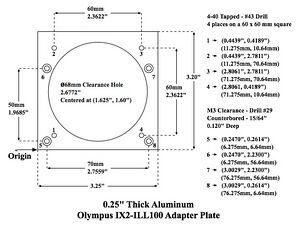User:Andy Maloney/Notebook/Lab Notebook of Andy Maloney/2009/03/10/Optical tweezers
IX2-ILL100 Adapter Plate
Well, I think that should put the new version of the Olympus IX2-IL100 adapter plate up.
I had to fuss with my original design to get the thing to work on our illumination arm. This of course means that our plate does not have these dimensions exactly. But, after remeasuring the illumination arm I'm confident that this is the correct design.
Of course, couple the plate to one of Thorlabs' 60mm cage cubes, and you have infinite possibilities to add optics to the microscope.
Since Olympus is a closed company (which makes them suck!) I bet that if they get wind of this, they will stop producing illumination arms with threaded holes. Or, better yet, they will make you purchase a different illumination arm with the threaded holes in it, but at a premium price.
[Insert very irritable cursing here about Olympus...]
PLT Laser Diode
Today we inserted the 1W 690 nm laser diode from PLT. I would recommend this company to people you don't like. We got the diode current up to 1.6 A with an output power of around 500 mW. This of course will get better as we collimate the light from the diode in a more efficient manner. PLT offers a FAC (fast axis collimation) as an option and I must say, it works very nicely. So, whatever company PLT purchased the diode from and then sold to us for 2x the amount, good job!
FAC collimation refers to collimating light along the axis that diverges the fastest. In our case, that would be along the axis perpendicular to the solid state junction, i.e. the y axis. I'm pretty sure that this is the axis that most laser diodes diverge the fastest in. Maybe just for the can package. This feature is great, and I'd recommend anyone getting it even if it is expensive. Of course, along the "slow" axis we still have to collimate it. We did this by using an asphere with anti reflection coatings at 690 nm.

